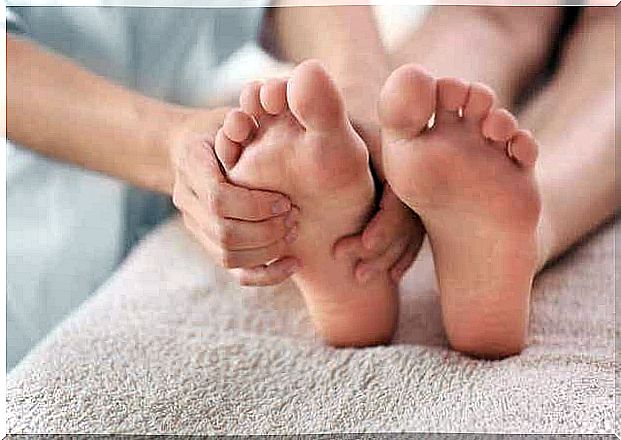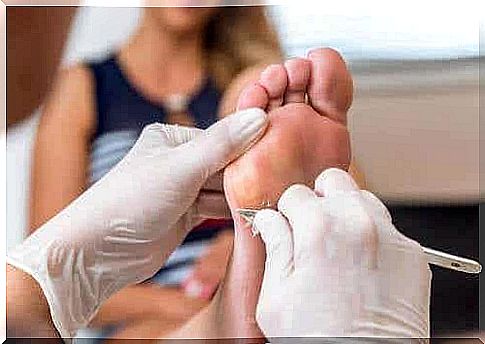When Should You See A Podiatrist?

While we tend to see a podiatrist for pain or discomfort, this professional’s function can also be preventive. Podiatry can prevent foot injuries before they appear. With that in mind, in this article, we’ll tell you when to see a podiatrist.
This field of health studies the feet in their anatomical and physiological context and goes well beyond the famous corns and the biometric study of the footprint. Rather, it is a specialty that considers the lower limbs as a functional whole.
Podiatrists can prevent, diagnose, treat and repair things about the feet. They can also correct ailments, prevent their appearance and restore footprint. Some countries require a degree, while others require a university degree.
Common Reasons to See a Podiatrist
As we mentioned, podiatry is not a science limited to treating corns and calluses. Several things in everyday life affect the anatomy and physiology of the foot. Podiatrists can therefore practice their knowledge there.
The most common reasons for consultation remain pain and discomfort. When we notice that our feet hurt too much, don’t walk well or there is a visible lesion, we go to the podiatrist.
However, we don’t have to wait for an injury to see a podiatrist. For example, if we are going to start a sport or have been practicing for a while, this professional can advise us. Exercise often forces and overloads our feet, and a podiatrist can correct poor posture (Spanish link) to prevent injury.
There is also the option to ask the professional to perform a biometric test of the footprint. By means of measurements and equipment, the podiatrist determines how the base of our foot is, where it rests too much and too little and what injury can occur if we do not solve the problem.

Conditions that podiatry can treat
Podiatrists have the ability to treat diseases that are already present in the foot. Sometimes they work together with a general practitioner or traumatologist, sometimes directly from their own expertise.
Podiatry can treat the following treatments:
- Repeated injuries: Some people often injure their feet or ankle joints. This could be the result of a wrong step. By biometrically evaluating the foot, it is possible to correct a poor stance.
- Poor posture due to age: With age, the bones of the foot weaken and deform, changing the way we walk. For example, a podiatrist can advise the elderly and their carers to improve gait dynamics and prevent falls.
- Ingrown Toenails: Podiatrists can remove ingrown toenails with minimally invasive surgery that takes just a few minutes and uses local anesthesia.
- Flat feet: A flat foot is a condition in which the inner arch of the foot is not fully formed. It can be painful if the individual is not wearing appropriate footwear.
- Calluses: podiatrists treat calluses with certain instruments.
- Hammertoes: Some people suffer from toe deformities, such as the hammertoe, which is the most common and consists of one toe that bends down on its own. This changes the footprint, the use of footwear and causes calluses.
- Bromhidrosis: This is the name of the intense odor of the feet due to a malfunction of the glands of the lower extremities. Sometimes there are concurrent infections that contribute to the bad smell. Sometimes it’s just a genetic flaw.

Treatments performed by a podiatrist
Podiatrists are trained to perform treatments if they detect an alteration that is within the scope of their knowledge. In that regard, one of the most common indications of these specialists is the use of insoles.
Insoles or arch supports are orthopedic treatments, that is, they are intended to correct deviations in the postural axis. So by improving our posture, we can prevent pain and joint disease.
While there are insoles that are freely available in stores, this is not a good idea. Instead, a podiatrist should always measure the foot to determine the right insole for each person. After all, the footprint is an individual characteristic that is unique to each person.
If necessary, the podiatrist can also perform minor procedures. As we mentioned above, the treatment of ingrown toenails and corns is possible with minimal instruments using nothing more than local anaesthetic.
It is important to remember that feet can return to their unhealthy position, ingrown toenails can return, or corns can reappear. That is why follow-up is also important in podiatry. For this reason, podiatrists make scheduled appointments to monitor and re-evaluate treatments.









